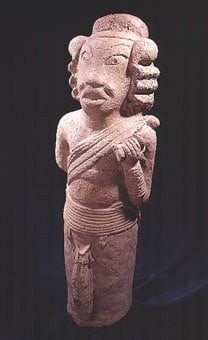Nok Terracotta Sculpture of a Warrior or a Hunter, 500 BCE - 200 CE
Terracotta
9 x 26.75
PF.4569 (LSO)
This beautiful and elegant ceramic depiction of a standing man was made by the Nok people of Nigeria, at the start of the first millennium AD. It is a columnar...
This beautiful and elegant ceramic depiction of a standing man was made by the Nok people of Nigeria, at the start of the first millennium AD. It is a columnar piece, with the legs pressed together, the left hand drawn up to the shoulder and holding what was once presumably a weapon, and the other hand partially obscured behind the back. He is attired in a corded belt/loincloth and a sash that encircles him from left shoulder to right hip. His head is very unusual, with oval pierced eyes, a flat nose and an open, thick-lipped mouth. His head is surmounted with what is either a hat or an extraordinary, curled coiffure. His status is high, to judge from the jewellery that encircles his wrists.
The astonishing artistry and early date of Nok pieces makes them among the most important artworks on the African continent. Comparatively little is known of the Nok culture, although the entity – which flourished between 900 BC and 200 AD – is technically a misnomer, for the artistic traditions it represents are the only common characteristics shared by communities that differed in all other respects. Their artworks constitute the most sophisticated and formalised early African artistic tradition outside Egypt. Technically, they are very unusual because of the manner in which coiled and subtractive sculpting methods were used to capture likenesses. Aesthetically, they are both naturalistic and expressionist, with highly distinctive elongated forms, triangular eyes, pierced pupils/nostrils and elaborate hairstyles. Substyles of the Nok tradition include the Jemaa Style, the Katsina Ala Style (elongated heads) and the Sokoto Style (elongated monobrow foreheads, lending a severe expression to the face) and random variants such as the Herm Statues of Kuchamfa (simplified cylindrical figures topped with normal heads) and the “standard” three-dimensional standing figures, which subscribe to the Jemaa style. It is to the Katsina Ala group that the current piece can be attributed.
The function of Nok art is unclear, although the care with which it is executed has led some to claim they represent nobility, or perhaps ancestors to which obeisance and sacrifices were offered. The largest ones may have been placed in structures that had ceremonial or ritual importance at the time, while smaller ones may have been personal or domestic talismans or deities/spirits. They are always socially elevated insofar as this can be ascertained (i.e. jewellery etc).
This is probably a warrior or some other high-ranking member of Nok society. It is a striking piece of African art.
The astonishing artistry and early date of Nok pieces makes them among the most important artworks on the African continent. Comparatively little is known of the Nok culture, although the entity – which flourished between 900 BC and 200 AD – is technically a misnomer, for the artistic traditions it represents are the only common characteristics shared by communities that differed in all other respects. Their artworks constitute the most sophisticated and formalised early African artistic tradition outside Egypt. Technically, they are very unusual because of the manner in which coiled and subtractive sculpting methods were used to capture likenesses. Aesthetically, they are both naturalistic and expressionist, with highly distinctive elongated forms, triangular eyes, pierced pupils/nostrils and elaborate hairstyles. Substyles of the Nok tradition include the Jemaa Style, the Katsina Ala Style (elongated heads) and the Sokoto Style (elongated monobrow foreheads, lending a severe expression to the face) and random variants such as the Herm Statues of Kuchamfa (simplified cylindrical figures topped with normal heads) and the “standard” three-dimensional standing figures, which subscribe to the Jemaa style. It is to the Katsina Ala group that the current piece can be attributed.
The function of Nok art is unclear, although the care with which it is executed has led some to claim they represent nobility, or perhaps ancestors to which obeisance and sacrifices were offered. The largest ones may have been placed in structures that had ceremonial or ritual importance at the time, while smaller ones may have been personal or domestic talismans or deities/spirits. They are always socially elevated insofar as this can be ascertained (i.e. jewellery etc).
This is probably a warrior or some other high-ranking member of Nok society. It is a striking piece of African art.
Literature
V24



